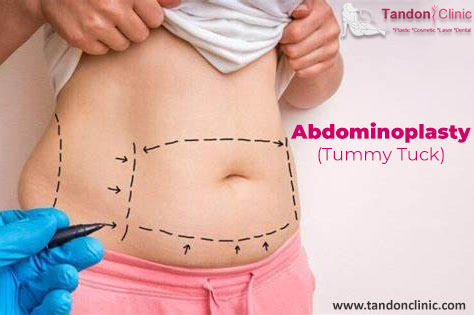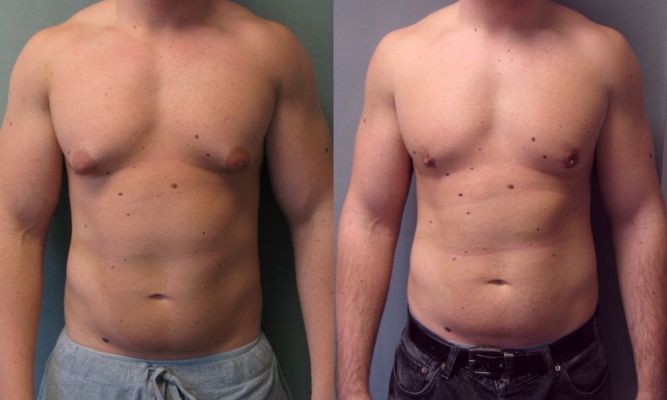According to data, between 40 and 60% of men in our country have gynecomastia, a medical condition in which their breasts develop too much and adopt an appearance similar to those of women. The growth of breasts in men occurs in the area under the areola, in one or both breasts, and can be an important aesthetic alteration and a problem of self-esteem for those who suffer.
The causes of gynecomastia in men are fundamentally two: the abnormal development of mammary glandular tissue (usually due to problems in the production of hormones such as estrogens and testosterone) and the increase of fatty tissue in the area as a result of an increase in weight (pseudogynecomastia due to obesity). Some men who consume anabolics to gain muscle mass also develop sagging breasts and gynecomastia.
As a general rule, gynecomastia is not considered a serious health problem. However, coping with the condition is not always easy. And, in addition to the aesthetic appearance, some patients experience swelling, pain and even secretion in one or both nipples. To end these discomforts, medications are used or cosmetic surgery in Delhi is used as a definitive solution for “male boobs.”

Preoperative study of the man’s chest
Before performing the male breast reduction in Delhi, plastic surgeon in Delhi must be very clear about what is the abnormal development of the breasts in order to establish how to remove fat from the breasts in men and achieve a flat and well-contoured chest, with scarcely visible scars and natural results.
The pre-gynecomastia study includes breast examination, measurement of certain physical parameters and general state of health, and photography. In more severe cases, mammograms are performed to rule out the presence of tumors. In addition to revealing the presence of breast cancer in men, mammograms allow you to study in detail the composition of the breast and its percentage of fat and glandular tissue. These data, together with the patient’s medical history (age, test results, electrocardiogram, ultrasound, etc.), will be essential to choose the best method for the male breast reduction in Delhi.
This pre-gynecomastia study also allows us to assess whether the abnormal development of the breasts is related to other pathologies (impaired liver function, hyperthyroidism, etc.) or to the consumption of medications, anabolics, etc. In this way, and if the problem has a medical cause, experts can refer the patient to the appropriate specialist before performing any surgical intervention.
Lose weight before undergoing a gynecomastia operation
Eliminating pectoral fat from man is the primary objective of gynecomastia, but is there a way to improve the process? Should patients follow directions before undergoing the intervention?
In cases of obesity pseudogynecomastia, before eliminating the pectoral fat of man it is advisable that he lose weight. The reason is very simple: the results of gynecomastia in men are significant and permanent, but the operation has some aesthetic risks (appearance of scars, changes in pigmentation in the areola or slightly asymmetric nipples) and related to the intervention (infections, injuries skin, excessive bleeding, appearance of seromas, etc.). In obese patients who want to eliminate chest fat, losing weight before the operation decreases the amount of breast tissue, so the procedure will be simpler, leave less scarring and there will be less risk of complications.
Types of incision to eliminate pectoral fat in men
The operation of chest gynecomastia in men consists, basically, in removing the male mammary glands through a small incision made in the areola or in removing fat from the area thanks to a liposuction in Delhi.
If the primary cause of gynecomastia is glandular excess, it is removed with a scalpel. The incision is made in a poorly visible area, on the edge of the areola, from which excess glandular tissue, fat and skin can be removed. This intervention is performed in a “U” shape and, if the patient’s skin is young and elastic, the scar will be virtually invisible. In case you need liposuction to remove excess fat, the cannula will be inserted through the existing incisions to reduce the amount of scars.
When gynecomastia is minimal and is done to remove a small amount of fat from a man’s chest, the incisions of liposuction are small (less than one centimeter). However, in the most severe cases, the removal of breast tissue and fat can lead to incisions and wide scars due to excess skin and tissue. He thinks that when a large amount of fat is removed from the chest, the skin may not fit well with the new body contour and a skin resection is necessary – remove excess skin – to allow the remaining skin to adapt to the new breast contour. In the most serious gynecomastia, incisions are made in the form of an “inverted T”, that is, vertical incisions and even the inframammary fold.
The intervention to remove excess fat in the man’s chest and reduce his breast tissue can be performed with general or local anesthesia. In both cases, and to guarantee the success and safety of the intervention, it is important to rely on a plastic surgeon in Delhi specialized in removing pectoral fat from men such as Dr. Ashok Tandon, specialist in Plastic, Reconstructive and Aesthetic Surgery.
Healing process of gynecomastia in men
After the operation of male breast reduction in Delhi, the patient may experience discomfort that is easy to reduce with the intake of painkillers. The intervened area will be swollen for several days and the use of elastic garments is recommended for a few months. Although most of the inflammation will disappear in a few weeks, the results of gynecomastia will not be definitive until one year has passed.
The patient can return to normal activity one week after the operation, although recovery should be progressive. If in the gynecomastia sutures have been made they will be removed in one or two weeks, so it is recommended by plastic surgeon in Pitampura to limit the efforts and physical activity until then.
Healing after gynecomastia does not reverse complications, although it depends on the type of skin and the genetic predisposition of each patient. The scars will have a reddish appearance during the first months. It is recommended cosmetic surgeon in Delhi to apply sterile strips and hydrate the area well following the instructions of the doctors. If the scars are deeper due to the removal of large amounts of tissues and skin (intervention in the form of “inverted T”) Sterile strips should be replaced with silicone strips to hydrate the area well and avoid complications that can lead to keloids (excess scar tissue in a pseudo-tumor and outside the edges of the initial wound) and hypertrophic scars (excessive proliferation of the scar).
It is also important to avoid sun exposure in the area for at least six months to avoid the appearance of pigmentation changes in the skin. If exposure is inevitable for any reason, it is essential to apply sunscreen.
28.706900
77.148657












